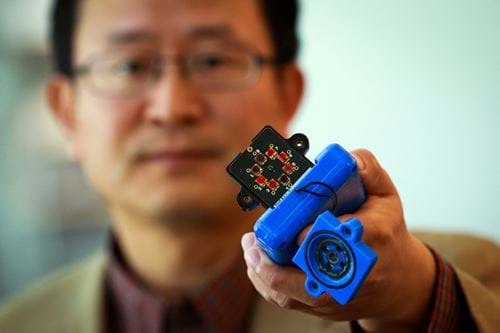Day 246: Keeping us all safer

28th January 2015
Author: Geoff Maitland, IChemE President 2014–2015.
Engineers and chemical engineers are continually trying to improve quality of life. But sometimes, simply protecting what we have already is the most important thing - life itself.
Over the past 15 years, terrorism has made the world more cautious, with increasing amounts of money spent on intelligence and prevention. Recent events in Paris suggest how hard the challenge is.

Some of the answers to detecting terrorism are technological and involves the expertise of engineers like Ling Zang, a University of Utah professor of materials science and engineering.
Ling and his team have developed a new type of carbon nanotube material for handheld sensors that will be quicker and better at sniffing out explosives, deadly gases and illegal drugs.
Carbon nanotubes are known for their strength and high electrical conductivity and are used in products from baseball bats and other sports equipment to lithium-ion batteries and touchscreen computer displays.
Zang and his team found a way to break up bundles of the carbon nanotubes with a polymer and then deposit a microscopic amount on electrodes in a prototype handheld scanner that can detect toxic gases such as sarin or chlorine, or explosives such as TNT.
When the sensor detects molecules from an explosive, deadly gas or drugs such as methamphetamine, they alter the electrical current through the nanotube materials, signalling the presence of any of those substances.
Ling says: “You can apply voltage between the electrodes and monitor the current through the nanotube.
“If you have explosives or toxic chemicals caught by the nanotube, you will see an increase or decrease in the current.”
By modifying the surface of the nanotubes with a polymer, the material can be tuned to detect any of more than a dozen explosives, including homemade bombs, and about two-dozen different toxic gases.
The technology has been packaged into a gadget which weighs less than a pound and is about the size of a clunky smart phone, could also be deployed on the battlefield to detect chemical weapons or other explosives.
The technology also can be applied to existing detectors or airport scanners used to sense explosives or chemical threats.
Tom Webster, chair of the Department of Chemical Engineering at Northeastern University said: “I think its pretty neat. I think it sounds like a great idea to me.
"If you had some gun power residue or chemical in the air, the idea they propose is that the carbon nanotubes can actually measure the conductivity of the air.”
When society is at its most vulnerable such as the Boston Marathon bombing, and in countries affected by political and social turmoil, portable and effective devices like Ling's may help combat terrorism and crime, and give a greater sense of safety to people going about their daily lives.
ChemEng365 blog
Geoff Maitland launched this blog during his IChemE presidency in 2014. ChemEng365 features 365 chemical engineering successes and achievements throughout his year-long presidency.